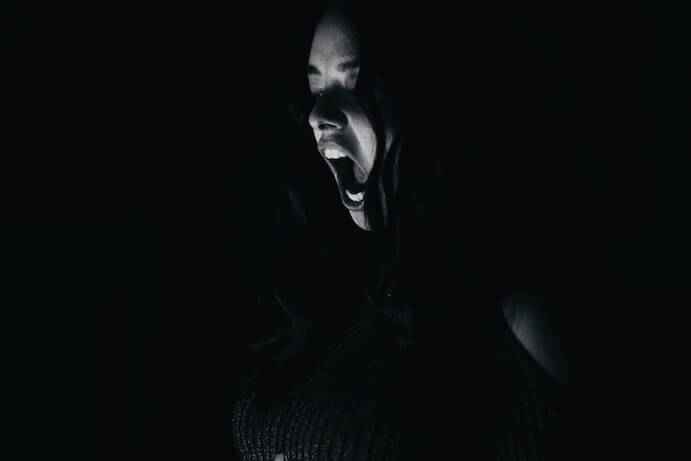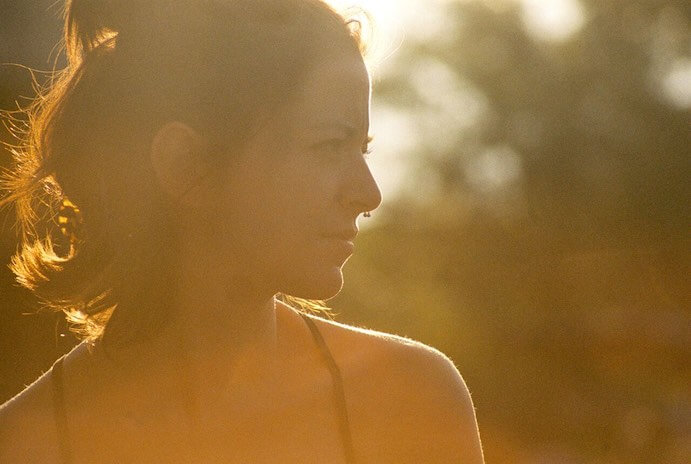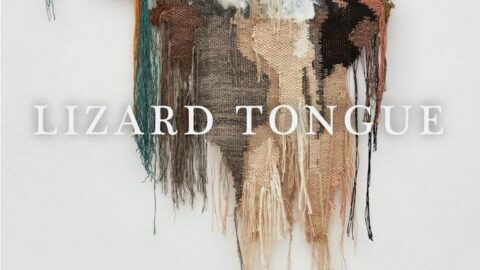Nina Dante + Bethany Younge find themselves in conversation with stones, shells, wind, sand, and lizards on their latest album of experimental vocal music, LIZARD TONGUE. Released September 8, 2021 on TAK Editions, the album is a journey through sonic landscapes that the duo creates as performers and composers with not only their voices, but also instruments made of wood, clay, jaw harps, whistles, and more.
The album immediately grabs the listener by the shirt collar in the opening seconds of The stones discuss. Raspy, growling vocal fries sit atop delicate rainstick-like wooden instruments that evoke a trickling effect, as if water were dripping from the eaves in a dense storm. Over the course of the piece, the intensity of the vocal fries gives way and allows the sputtering percussion to come into the forefront, creating an organic segue to the next track. The shells dance is a finespun hocket between tiny clinking shells, sewn together by breathy inhales and exhales, only to be punctuated by sustained timbral trills, the first sustained pitches of the album. The haunting tones of the voices warble and quaver, as if a sonic disturbance had rippled the waves of a still lake.

When the frogs wake immerses the listener in an environment of frog imitation from shrill, trilling coquis to the lower, muted glottal stops of larger frogs. The track alters between these two extremes, creating a form that smacks the listener awake, then slowly dissipates in intensity and range until it reaches a calm, meditative imitation of dripping water from the natural instruments.
The birds of the heavens sing to the reptiles and the reptiles sing back is the centerpiece of the seven-track album, focusing on fluttery, ethereal whistles before the performers blow bubbles and revive the raspy voice from the first track. The innocent, straight tones of the whistles occasionally waver into trills and drown into the background of the soundscape, allowing the bubbles to take over. The vocal fry emerges as if gasping for air, a sea creature exposed above the surface for short bursts of time. The piece ends with a hauntingly naïve whistle melody that sings far off in the distance as the bubbles continue to occupy the forefront of the texture.

While the album is relatively devoid of phonemes up until this point, When there’s no wind blowing clearly includes “no, no, no, no, no….” in the first half of the soundscape. This offers a myriad of interpretation on part of the listener, given the many ways in which these syllables integrate into different languages. While language certainly would play a key role in a listener’s comprehension, there is no doubt of this track’s originality in its use of syllabic content and syntax, bringing the listener up and down a rollercoaster of accelerations and decelerations, crescendo and decrescendo.
Then, time stops with the slow, controlled exhale featured in The breathing sands. Just as different white noise filters fade and spill into one another, highlighting different sibilance and frequencies, Dante + Younge’s exhales transfix the listener, as if someone continued to turn the dial from static to static on a radio. The regular pulsations that transpire from this texture throb against the sustains, collapsing into fragile gasps that occasionally blossom into airy straight tones and gossamery harmonies.

The album closes with its title track, The lizard’s tongue. Like a bookend to the first track, raspy whispers create a complex texture over which long sustains quiver and undulate, breaking out into a surprisingly folky melody at the end of the piece, complete with tremolos and text. The duo quickly introduces this material, and then the piece abruptly ends, leaving the listener wanting more of the glorious, warbling melody that emerges, only to be quelled seconds later.
LIZARD TONGUE creates a visceral experience unmatched by many other vocal groups. Through aggressive growls and meek straight tones, what is most impressive is the duo’s ability to find organic textures which create a holistic experience between improvisation, composition, and performance. The natural theme of the album likewise is a unique blend of electronic and acoustic, allowing the instruments to flawlessly mix with their voices, and still never sounding overly processed or dated. LIZARD TONGUE is full of vertical cliff distinctions between textures and immersive worlds that makes one wonder where the voices end and where the instruments start, which makes the album dynamic and fascinating to listen to.
I CARE IF YOU LISTEN is an editorially-independent program of the American Composers Forum, funded with generous donor and institutional support. Opinions expressed are solely those of the author and may not represent the views of ICIYL or ACF.
A gift to ACF helps support the work of ICIYL. For more on ACF, visit the “At ACF” section or composersforum.org.
























